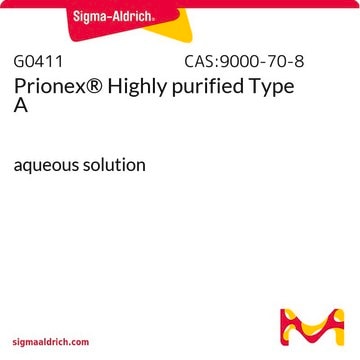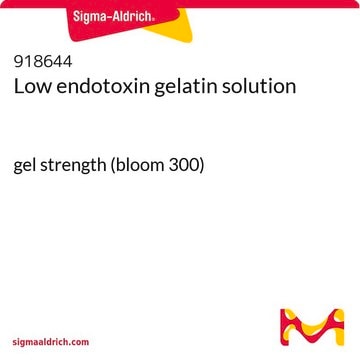924504
Gelatin Type A
300 Bloom, Low endotoxin
Sinónimos:
300 Bloom, 3D Bioprinting, GelMA, Gelatin, Gelatin methacrylamide, Gelatin methacrylate, Gelatin methacryloyl
Iniciar sesiónpara Ver la Fijación de precios por contrato y de la organización
About This Item
UNSPSC Code:
12352201
NACRES:
NA.23
Productos recomendados
Quality Level
form
powder or chunks
impurities
<10 CFU/g Bioburden
<125 EU/g Endotoxin
color
white to pale yellow
storage temp.
2-8°C
Categorías relacionadas
Application
Low endotoxin gelatin, type A is sterile filtrated through 0.2 μm sterile filter, and lyopholized for use in biomedical applications.
Gelatin is widely used for tissue engineering and 3D bioprinting. Gelatin is derived from natural extracellular matrix (ECM) components. Due to its low cost, abundance, and retention of natural cell binding motifs, gelatin has become a highly sought material for tissue engineering applications. Gelatin solution has thermoreversible gelling property which enables synthesis of biocompatible and biodegradable hydrogels and promote cell adhesion, spreading, and proliferation.
Gelatin is widely used for tissue engineering and 3D bioprinting. Gelatin is derived from natural extracellular matrix (ECM) components. Due to its low cost, abundance, and retention of natural cell binding motifs, gelatin has become a highly sought material for tissue engineering applications. Gelatin solution has thermoreversible gelling property which enables synthesis of biocompatible and biodegradable hydrogels and promote cell adhesion, spreading, and proliferation.
Packaging
500 mg in glass bottle
Storage Class
11 - Combustible Solids
wgk_germany
WGK 3
flash_point_f
Not applicable
flash_point_c
Not applicable
Certificados de análisis (COA)
Busque Certificados de análisis (COA) introduciendo el número de lote del producto. Los números de lote se encuentran en la etiqueta del producto después de las palabras «Lot» o «Batch»
¿Ya tiene este producto?
Encuentre la documentación para los productos que ha comprado recientemente en la Biblioteca de documentos.
J M Harlan et al.
Laboratory investigation; a journal of technical methods and pathology, 48(3), 269-274 (1983-03-01)
Lipopolysaccharide (LPS) produced time- and dose-dependent bovine endothelial cell injury in vitro that was manifested initially by cell detachment from culture substrate with subsequent cell lysis. Bovine endothelial cell injury was observed with LPS derived from Salmonella minnesota R595, a
K W Brunson et al.
Journal of supramolecular structure, 9(2), 231-242 (1978-01-01)
Chinese hamster ovary (CHO . K1 . PRO) cell growth was inhibited by addition of a gram-negative bacterial lipopolysaccharide (LPS) to the cell culture medium. Growth inhibition began after three or four days of incubation, was dose-dependent up to a
T Kirikae et al.
International journal of immunopharmacology, 19(5), 255-262 (1997-05-01)
Trace amounts of endotoxin (lipopolysaccharide: LPS) are assumed to contaminate commercially available fetal bovine serum (FBS) for tissue or cell culture during the manufacturing process. We examined how cultured cells were affected by the endotoxin and how much endotoxin was
J Ongrádi et al.
Folia microbiologica, 29(6), 450-454 (1984-01-01)
Cytotoxicity of a mixed pyrogen preparation and its components as well as native and radiodetoxified lipopolysacharides (LPS) was determined with established HEp-2 cell cultures and by measuring plating efficiency. This proved to be more sensitive to the damaging effect of
J G Brock-Utne et al.
Anaesthesia and intensive care, 17(1), 49-55 (1989-02-01)
Endotoxins (lipopolysaccharides, LPS) are potent bacterial poisons always present within the intestines in considerable amounts. Several pathophysiological conditions such as hypovolaemia, hypoxia, intestinal ischaemia, burns and radiation lead to a breakdown in the barrier and depending upon the extent of
Nuestro equipo de científicos tiene experiencia en todas las áreas de investigación: Ciencias de la vida, Ciencia de los materiales, Síntesis química, Cromatografía, Analítica y muchas otras.
Póngase en contacto con el Servicio técnico








